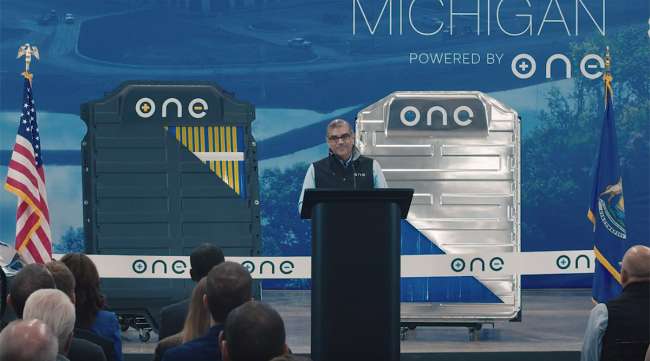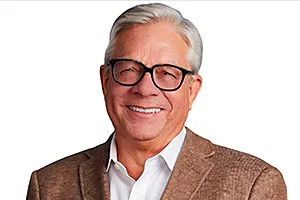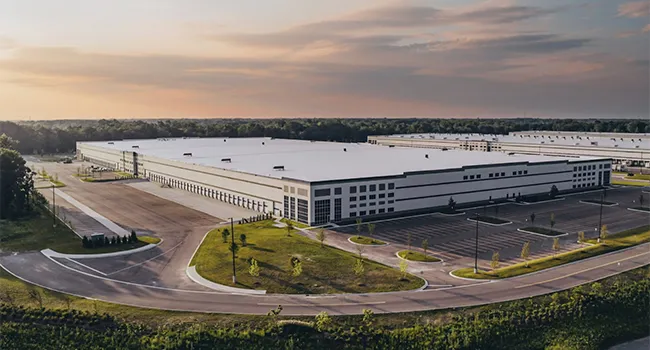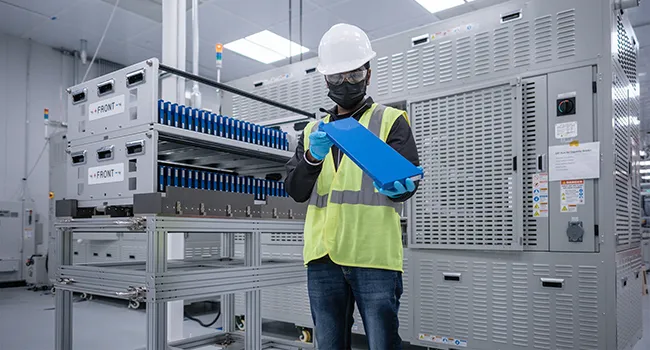Battery Startup ONE Demotes CEO Amid Cash Crunch

[Stay on top of transportation news: Get TTNews in your inbox.]
Our Next Energy, a battery startup that hopes to rival China with vital energy storage technology, has replaced founder and CEO Mujeeb Ijaz as it faces a failed funding round and cash crunch.
ONE has installed board member Paul Humphries as CEO, the company confirmed in an interview Dec. 8 at its Michigan headquarters.
Democratic politicians including Michigan Gov. Gretchen Whitmer and former House Speaker Nancy Pelosi have touted ONE, as it’s known, as a poster child of President Biden’s agenda to wean the U.S. off China by supporting American manufacturing and green jobs in the U.S. The success of the startup is a vital piece of a national effort to develop a homegrown battery industry in the U.S.
Ijaz, a battery engineer who worked at Ford Motor Co. and on Apple Inc.’s secretive electric car project, came from a startup once funded by the Obama Administration called A123 Systems Inc. that went bankrupt in 2012. Its technology was acquired by Wanxiang Group in 2013. With that sale, America’s chance to lead in battery technology was fumbled away to China.
The three-year-old startup is developing batteries that use lithium-iron phosphate chemistry technology, known as LFP, which is cheaper and more stable than the nickel-based lithium ion batteries popular in the West. Currently, China’s Contemporary Amperex Technologies Ltd, or CATL, and BYD Co. are the world’s dominant LFP battery producers.

Humphries via one.ai
Humphries, 68, a veteran of contract manufacturer Flex Ltd., took over the role last week. He has been informally overseeing operations since Thanksgiving.
Ijaz said he voluntarily stepped aside and recruited Humphries for the job. He will remain as chief technology officer overseeing product development, and serve as vice chairman of ONE’s six-member board. The company is in the process of raising more money and has a term sheet, he said, while declining to give details.
“Our company is viable and healthy, because we have the support of our board and our business plan has been well received,” Ijaz said in an exclusive interview at ONE’s offices in Novi, Mich.
The leadership changes come at a tumultuous time for ONE, which has been building a $1.6 billion manufacturing plant in Van Buren, Mich., funded in part by about $200 million in state grants. The company announced late last month it was laying off 128 people, or about 25% of its staff, in response to “market conditions” and to “focus on core priorities.”

ONE is building a $1.6 billion manufacturing plant in Van Buren, Mich. (one.ai)
The layoffs were triggered by a cash crunch after Just Climate, a London-based investment fund focused on decarbonization, canceled plans to lead ONE’s Series C funding round with a $100 million investment, according to three people familiar with the matter.
The investment fund declined to comment on its negotiations with ONE. Ijaz maintained the fund walked away because of a difference of opinion over revenue projections and how quickly the startup could land a major automotive customer for its batteries.
ONE’s business plans have been tested as EV demand softens, with automakers like General Motors Co. and Ford dialing back or postponing investments in fully electric cars. Republicans in Congress are also talking about defunding President Biden’s signature climate law.
The startup is now retooling to respond to a lower demand, Ijaz said. It’s delaying the buildout of its 20 gigawatt-hour battery plant in Van Buren until it has a firm commitment from a customer to buy its cells. The company still plans to produce sample cells for customers in the first quarter of next year. In the meantime, ONE will continue buying cells from China’s BYD Co. through 2025 to place in its Aries Grid battery packs, which are designed for both commercial electric vehicles and stationary storage.

An employee at ONE’s Van Buren, Michigan, plant shows off an LFP prototype cell. (one.ai)
ONE’s goal is to become a U.S.-based competitor to Chinese battery manufacturers led by CATL, which has been making inroads into the U.S. market. Trade protections on Chinese imports and battery manufacturing subsidies under President Biden’s signature climate law, the Inflation Reduction Act, are key for the company to be able to compete against lower-cost Chinese rivals, Ijaz said.
Ijaz is known in the battery world as a visionary engineer. He’s been a central piece of the investment thesis behind ONE, but his ambition has been tempered by a lack of discipline around financial decisions.
He did not heed warnings from colleagues that the startup was hiring too many people and spending too much, said people with knowledge of the company’s operations, who were unauthorized to speak publicly on the matter.
As for his management style, Ijaz said that while he has strong opinions, the company has never been a “yes” culture that discouraged dissent. He said he has been learning about leadership in recent weeks by watching Humphries interact with employees.
Want more news? Listen to today's daily briefing above or go here for more info
“I realized that actually I have a lot to learn about running a billion-dollar company,” Ijaz said. “We don’t want to lose this opportunity.”
Humphries, whose career spans more than 30 years in manufacturing, said he has a track record of expanding and incubating new businesses and leading turnarounds at several companies, including auto supplier BorgWarner. He also spent six years as head of human relations at Flex before becoming a group president. He came out of retirement and is moving to Michigan from California to lead ONE.
“I want to make sure that we can still have Mujeeb’s influence and approach to things while at the same time putting a little bit more structure around it, and making sure we can deliver on what we say,” Humphries said. “I want to see Mujeeb realize his vision, and I want to see the 300-odd jobs we have left protected.”




